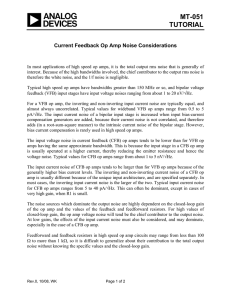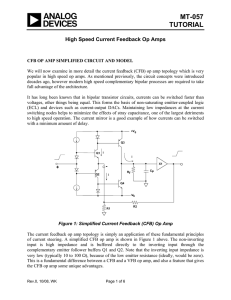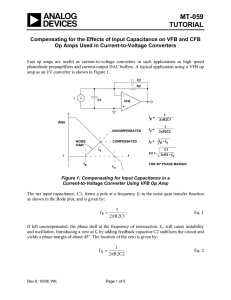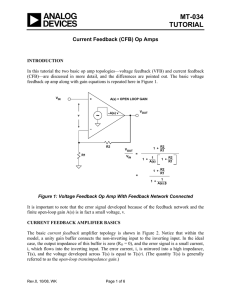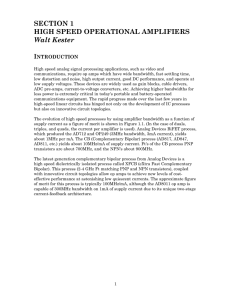MT-058 TUTORIAL Effects of Feedback Capacitance on VFB and CFB Op Amps
advertisement
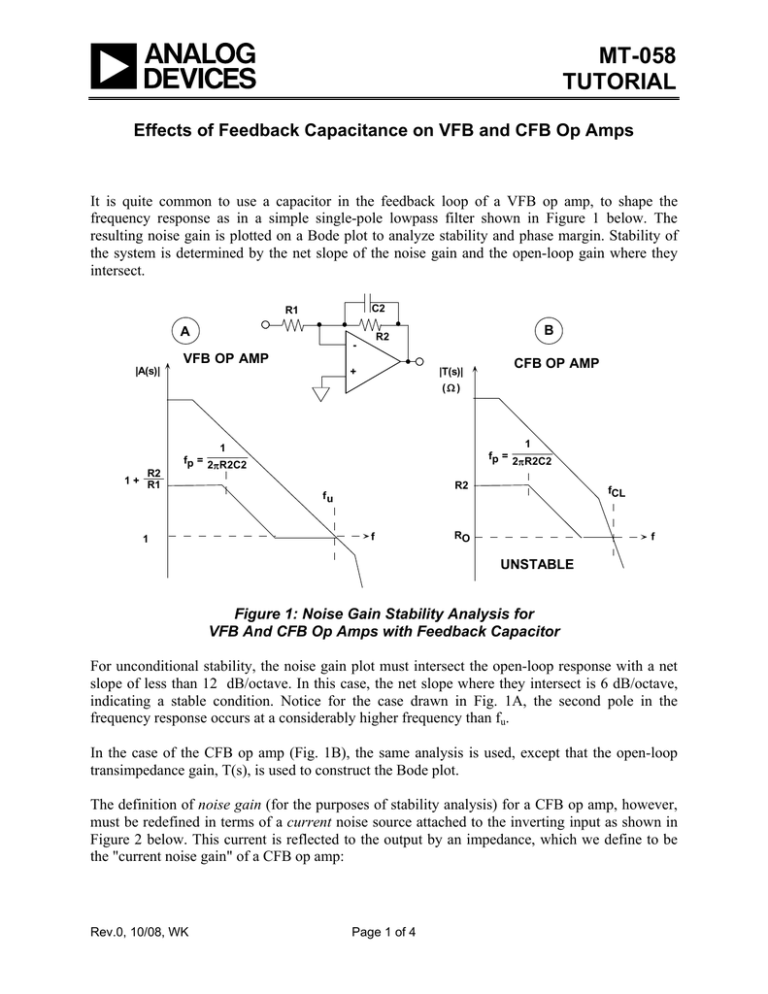
MT-058 TUTORIAL Effects of Feedback Capacitance on VFB and CFB Op Amps It is quite common to use a capacitor in the feedback loop of a VFB op amp, to shape the frequency response as in a simple single-pole lowpass filter shown in Figure 1 below. The resulting noise gain is plotted on a Bode plot to analyze stability and phase margin. Stability of the system is determined by the net slope of the noise gain and the open-loop gain where they intersect. C2 R1 A B R2 - VFB OP AMP |A(s)| R2 1 + R1 + CFB OP AMP |T(s)| (Ω ) 1 1 fp = 2πR2C2 fp = 2πR2C2 R2 fCL fu 1 f RO f UNSTABLE Figure 1: Noise Gain Stability Analysis for VFB And CFB Op Amps with Feedback Capacitor For unconditional stability, the noise gain plot must intersect the open-loop response with a net slope of less than 12 dB/octave. In this case, the net slope where they intersect is 6 dB/octave, indicating a stable condition. Notice for the case drawn in Fig. 1A, the second pole in the frequency response occurs at a considerably higher frequency than fu. In the case of the CFB op amp (Fig. 1B), the same analysis is used, except that the open-loop transimpedance gain, T(s), is used to construct the Bode plot. The definition of noise gain (for the purposes of stability analysis) for a CFB op amp, however, must be redefined in terms of a current noise source attached to the inverting input as shown in Figure 2 below. This current is reflected to the output by an impedance, which we define to be the "current noise gain" of a CFB op amp: Rev.0, 10/08, WK Page 1 of 4 MT-058 R ⎞ ⎛ " CURRENT NOISE GAIN" ≡ R O + Z2⎜1 + O ⎟ . Z1 ⎠ ⎝ Eq. 1 Now, return to Fig. 1B, and observe the CFB current noise gain plot. At low frequencies, the CFB current noise gain is simply R2 (making the assumption that Ro is much less than Z1 or Z2. The first pole is determined by R2 and C2. As the frequency continues to increase, C2 becomes a short circuit, and all the inverting input current flows through RO (again refer to Fig. 1B). T(s) X1 VOUT X1 i RO Z1 Z2 VOUT Z2 CURRENT "NOISE GAIN" i RO = VOUT i R = RO +Z2 1+ O Z1 ( Z1 ) Figure 2: Current "Noise Gain" Definition for CFB Op Amp for Use in Stability Analysis A CFB op amp is normally optimized for best performance for a fixed feedback resistor, R2. Additional poles in the transimpedance gain, T(s), occur at frequencies above the closed-loop bandwidth, fcl, (set by R2). Note that the intersection of the CFB current noise gain with the open-loop T(s) occurs where the slope of the T(s) function is 12 dB/octave. This indicates instability and possible oscillation. It is for this reason that CFB op amps are not suitable in configurations which require capacitance in the feedback loop, such as simple active integrators or lowpass filters. A CFB op amp is normally optimized for best performance for a fixed feedback resistor, R2. Additional poles in the transimpedance gain, T(s), occur at frequencies above the closed-loop bandwidth, fcl, (set by R2). Note that the intersection of the CFB current noise gain with the open-loop T(s) occurs where the slope of the T(s) function is 12 dB/octave. This indicates instability and possible oscillation. It is for this reason that CFB op amps are not suitable in configurations which require capacitance in the feedback loop, such as simple active integrators or lowpass filters. Page 2 of 4 MT-058 They can, however, be used in certain active filters such as the Sallen-Key configuration shown in Figure 3, which do not require capacitance in the feedback network. VIN VOUT R2 R1 R2 FIXED FOR CFB OP AMP Figure 3: The Sallen-Key Filter Configuration On the other hand, VFB op amps, do make very flexible active filters. A multiple feedback 20 MHz lowpass filter example using an AD8048 op amp is shown below in Figure 4. In general, an active filter amplifier should have a bandwidth that is at least ten times the bandwidth of the filter, if problems due to phase shift of the amplifier are to be avoided. (The AD8048 has a bandwidth of over 200 MHz in this configuration). Figure 4: Multiple feedback 20MHz Lowpass Filter Using the AD8048 VFB Op Amp Design details of this particular filter design can be found on the AD8048 data sheet. Further discussions on active filter design are included in Chapter 5 of the references. A Filter Wizard design tool is available on the Analog Devices' website to assist in active filter design. Page 3 of 4 MT-058 REFERENCES 1. Hank Zumbahlen, Basic Linear Design, Analog Devices, 2006, ISBN: 0-915550-28-1. Also available as Linear Circuit Design Handbook, Elsevier-Newnes, 2008, ISBN-10: 0750687037, ISBN-13: 9780750687034. Chapter 1. 2. Walter G. Jung, Op Amp Applications, Analog Devices, 2002, ISBN 0-916550-26-5, Also available as Op Amp Applications Handbook, Elsevier/Newnes, 2005, ISBN 0-7506-7844-5. Chapter 1. Copyright 2009, Analog Devices, Inc. All rights reserved. Analog Devices assumes no responsibility for customer product design or the use or application of customers’ products or for any infringements of patents or rights of others which may result from Analog Devices assistance. All trademarks and logos are property of their respective holders. Information furnished by Analog Devices applications and development tools engineers is believed to be accurate and reliable, however no responsibility is assumed by Analog Devices regarding technical accuracy and topicality of the content provided in Analog Devices Tutorials. Page 4 of 4
